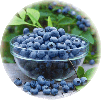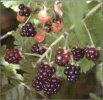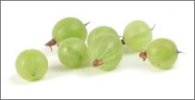|
|

|

The 15 Healthiest Berries You Could Possibly Eat ... Including 7 Most Haven't Heard Of
by www.SixWise.com Fresh berries hanging from a branch are some of summer's
most anticipated gifts. Now is the time of year when these
naturally sweet, tasty treats are available in plenty, but
you can enjoy them in frozen varieties year-round. So go ahead
and indulge in all that berries have to offer--a sweet, juicy
taste reminiscent of long summer days, an easy addition to
snacks and meals, and, best of all, incredible health benefits
for you and your family.
Here are fifteen of the healthiest ... and tastiest.
| 1. Blueberry |
|
 The
blueberry is quite possibly the healthiest fruit there
is--it ranked number one in antioxidant capacity by
researchers at the USDA Human Nutrition Center when
compared to 40 other fresh fruits and vegetables. The
blueberry is quite possibly the healthiest fruit there
is--it ranked number one in antioxidant capacity by
researchers at the USDA Human Nutrition Center when
compared to 40 other fresh fruits and vegetables.
"When it comes to brain protection, there's nothing
quite like blueberries," says Tufts neuroscientist
James Joseph. "I call the blueberry the brain berry,"
he says, attributing the effect to their antioxidant
and anti-inflammatory properties.
And the American Institute for Cancer Research has
this to say: "We now know that blueberries are
one of the best sources of antioxidants, substances
that can slow the aging process and reduce cell damage
that can lead to cancer."
Aside from protecting the brain and fighting cancer,
blueberries have been associated with lower cholesterol,
protection against heart disease, macular degeneration,
glaucoma, varicose veins, hemorrhoids and peptic ulcers,
and healthier elimination.
Rich in vitamins C and E, manganese and dietary fiber,
about 30 different species of blueberries grow throughout
the United States and Canada.
|
|
|
| 2. Cherry |
|
 As
if their sweet taste wasn't enough of a reason to eat
them, cherries are rich in queritrin (a flavonoid that's
a potent anti-cancer agent), anthocyanins and bioflavonoids
(compounds that fight the pain from arthritis, gout
and migraines), ellagic acid (another potent anti-cancer
agent) and melatonin (which may help you sleep). They
also contain the soluble fiber pectin, vitamin C, beta-carotene
and potassium. As
if their sweet taste wasn't enough of a reason to eat
them, cherries are rich in queritrin (a flavonoid that's
a potent anti-cancer agent), anthocyanins and bioflavonoids
(compounds that fight the pain from arthritis, gout
and migraines), ellagic acid (another potent anti-cancer
agent) and melatonin (which may help you sleep). They
also contain the soluble fiber pectin, vitamin C, beta-carotene
and potassium.
If it seems like cherries are only around for a short
time, you're right--their season is only three months
long. Cherries come in two basic varieties, sweet and
sour. The Bing cherry is the most popular of the sweet
cherries and is best for snacking, while the smaller
and brighter sour cherries are most often used for pies,
sauces or other baked goods. For a treat, try the incredibly
sweet and selectively grown Rainier cherries.
|
|
|
| 3. Strawberry |
|
 Like
other berries, strawberries contain phytonutrients called
phenols that make it a heart-protective, anti-cancer
and anti-inflammatory fruit. Strawberries also help
protect the brain from oxidative stress and age-related
decline and fight macular degeneration of the eyes.
They're an excellent source of vitamins C and K, manganese,
fiber and iodine, and they contain potassium, folate,
riboflavin, vitamin B5, omega-3 fatty acids, vitamin
B6, magnesium and copper. Like
other berries, strawberries contain phytonutrients called
phenols that make it a heart-protective, anti-cancer
and anti-inflammatory fruit. Strawberries also help
protect the brain from oxidative stress and age-related
decline and fight macular degeneration of the eyes.
They're an excellent source of vitamins C and K, manganese,
fiber and iodine, and they contain potassium, folate,
riboflavin, vitamin B5, omega-3 fatty acids, vitamin
B6, magnesium and copper.
There are over 600 varieties of berries out there,
and they can be used in everything from salads to breakfast
shakes to desserts. Because strawberries don't ripen
any further once they're picked, be sure to choose shiny
berries with a deep red color and use them within a
few days.
|
|
|
| 4. Bilberry |
|
 Similar
to the blueberry, bilberries are often referred to as
European blueberries. They're rich in antioxidants and
are widely known as a potent protector of the eyes and
have been linked to improvements in night vision, cataracts,
macular degeneration and vision overall. Similar
to the blueberry, bilberries are often referred to as
European blueberries. They're rich in antioxidants and
are widely known as a potent protector of the eyes and
have been linked to improvements in night vision, cataracts,
macular degeneration and vision overall.
Interestingly, the eye-protective benefits of bilberries
were first noticed during World War II when British
Royal Air Force (RAF) pilots discovered that they had
better night vision on bombing raids when they ate bilberry
preserves beforehand.
The bilberry also contains compounds that enhance blood
flow to circulatory vessels, which means it may be beneficial
for circulatory problems including varicose veins, hemorrhoids
and more.
Bilberries taste just like blueberries, but they're
about three times smaller in size.
|
|
|
| 5. Blackberry |
|
 Blackberries
contain antioxidants, vitamins C and E, and ellagic
acid, all of which may protect against cancer and fight
chronic disease. They're also rich in the soluble fiber
pectin, which may help lower cholesterol, and potassium. Blackberries
contain antioxidants, vitamins C and E, and ellagic
acid, all of which may protect against cancer and fight
chronic disease. They're also rich in the soluble fiber
pectin, which may help lower cholesterol, and potassium.
Wild blackberries are actually related to the rose,
and, like a rose, they grow on a thorny bush. Because
they're highly perishable (like all berries), blackberries
should, ideally, be used the same day they're bought
and washed just prior to eating. You can also freeze
them by placing them in a single layer on a cookie sheet
and then, once frozen, transferring them to an airtight
container. They'll keep for about six months.
|
|
|
| 6. Elderberry |
|
 In
400 B.C., Hippocrates referred to the elder tree as
his "medicine chest," and it's been used since
ancient times to treat colds, flus, arthritis, constipation
and more. Today, the elderberry is still in popular
demand when it comes to health, especially in Austria,
Germany and England. In
400 B.C., Hippocrates referred to the elder tree as
his "medicine chest," and it's been used since
ancient times to treat colds, flus, arthritis, constipation
and more. Today, the elderberry is still in popular
demand when it comes to health, especially in Austria,
Germany and England.
Elderberries contain plenty of antioxidants, anti-viral
compounds, anthocyanins that help enhance immune function,
and compounds that help lower LDL (bad) cholesterol.
The berries are small and round and range in color
from dark purple to bluish-black. Elderberries
should not be eaten raw, as they're mildly poisonous
and can cause nausea or vomiting if eaten unripe (and
they're quite sour). The mild toxicity is destroyed
by cooking, though, so the berries are typically used
to make jams, jellies and homemade wine. They can also
be used in place of blueberries in things like muffins,
cakes and pies.
|
|
|
| 7. Goji
Berries |
|
 It's
said that a handful of goji berries in the morning will
make you happy for the rest of the day. Traditionally,
they're regarded as a potent food for longevity, strength
and sexual virility and are grown in Tibet in protected
valleys that contain million-year-old soil that's reportedly
untouched by pollutants or pesticides. It's
said that a handful of goji berries in the morning will
make you happy for the rest of the day. Traditionally,
they're regarded as a potent food for longevity, strength
and sexual virility and are grown in Tibet in protected
valleys that contain million-year-old soil that's reportedly
untouched by pollutants or pesticides.
As tradition goes, the berries are never touched by
human hands (this would cause them to oxidize and turn
black), but instead are shaken onto mats and then dried
or made into a liquid juice. There's even a legend that
says Li Qing Yuen, who "lived to the age of 252
years" (1678-1930), ate Goji berries every day.
Modern day studies have also found some benefits to
goji berries; they've been said to have potential in
fighting cancer and protecting the liver. Goji berries
contain 18 amino acids, 21 trace minerals, linoleic
acid, more beta carotene than carrots, vitamins B1,
B2, B6, and E, selenium and germanium.
Goji berries are deep red in color and about the same
size as a raisin. They taste like a cranberry combined
with a cherry, and are typically eaten dried or in juice
form.
|
|
|
| 8. Lingonberries |
|
 These
small, red, oval fruits (they're about the size of a
large pea) are a popular treat in Finland and other
Nordic countries where their tart flavor is enjoyed
in sauces and jellies. These
small, red, oval fruits (they're about the size of a
large pea) are a popular treat in Finland and other
Nordic countries where their tart flavor is enjoyed
in sauces and jellies.
Lingonberries are rich in the flavonoid quercetin,
which is a plant antioxidant that may help to prevent
cancer and heart disease. Fresh lingonberries are not
easy to find in the United States, but if you do find
them, you can use them as you would a cranberry. They're
often eaten crushed and mixed with sugar or cooked into
sauces, jams, jellies, juice and wine.
If you haven't heard of the lingonberry, maybe you've
heard of one of its numerous other names: cowberry,
red whortle berry, foxberry, northern mountain cranberry,
dry ground cranberry, rock cranberry, partridge berry
or whimberry. Or maybe not.
|
|
|
| 9. Cranberries |
|
 One
of the most popular uses of cranberries, to treat urinary
tract infections, has been used for centuries by indigenous
cultures. Today researchers have found that cranberries
contain proanthocyanidins (PACs), which inhibit bacteria,
including E. coli, from adhering to the urinary tract,
thereby protecting it from infection. One
of the most popular uses of cranberries, to treat urinary
tract infections, has been used for centuries by indigenous
cultures. Today researchers have found that cranberries
contain proanthocyanidins (PACs), which inhibit bacteria,
including E. coli, from adhering to the urinary tract,
thereby protecting it from infection.
They're also rich in antioxidants that may play a role
in preventing heart disease and cancer, and may play
a role in preventing peptic ulcers by inhibiting H.
pylori from adhering to the stomach.
Because cranberries are so tart, they're not usually
eaten raw but instead are baked into pies, muffins and
cakes, used as a juice or cooked into the American holiday
favorite, cranberry sauce.
|
|
|
| 10. Raspberry |

Raspberries are rich in phytonutrients for antioxidant,
antimicrobial and anticarcinogenic protection. Chief
among these is ellagic
acid, the potent cancer fighter. Raspberries have
also been found to help prevent macular degeneration,
and they contain manganese, vitamin C, riboflavin, folate,
niacin, magnesium, potassium, dietary fiber and copper.
Raspberries have a long history--they can be traced
all the way back to prehistoric times--but began to
be grown widely in the 19th century, when many new varieties,
including the loganberry and boysenberry, were developed.
Raspberries have a sweet, tangy taste that makes them
a popular treat for snacks, desserts, salads, cereals,
sauces, baking, jams, jellies and more.
|
|
|
| 11. Dewberry |

Dewberries are closely related to raspberries and blackberries,
with the same sweet taste, but are slightly smaller
and typically purple in color. It is likely that they
present similar health benefits to raspberries and blackberries.
|
|
|
| 12. Mulberry |
|
 Traditionally,
mulberry fruit has been used medicinally to treat the
kidneys, fatigue, anemia and weakness. Although not
widely studied, it's thought that mulberries contain
high levels of antioxidants and similar health benefits
as other dark-colored berries like blueberries, blackberries
and raspberries. Traditionally,
mulberry fruit has been used medicinally to treat the
kidneys, fatigue, anemia and weakness. Although not
widely studied, it's thought that mulberries contain
high levels of antioxidants and similar health benefits
as other dark-colored berries like blueberries, blackberries
and raspberries.
The mulberry has a sweet, somewhat bland flavor, and
is commonly used in jelly, wine and desserts. In its
dry form, the mulberry can be used as a raisin substitute.
|
|
|
| 13. Gooseberry |
|
 These
fruits grow wild throughout the United States, but they're
typically cultivated in more tropical locations like
Hawaii and South Africa. They can range in color from
white to green to pink or purple, and they're typically
about 1/2 to 1 inch wide (though some varieties can
grow as big as plums!). These
fruits grow wild throughout the United States, but they're
typically cultivated in more tropical locations like
Hawaii and South Africa. They can range in color from
white to green to pink or purple, and they're typically
about 1/2 to 1 inch wide (though some varieties can
grow as big as plums!).
Gooseberries have a sweet/sour taste somewhere between
a strawberry and a pineapple. Though not too common
in the United States these days, they taste great in
pies, jams, jellies and cooked sauces, or eaten fresh,
if you can find them. If you're looking for a sweeter
berry, choose a gooseberry with a pinkish hue. The green
berries are unripe and work best for sauces and pies.
Gooseberries have similar nutritional qualities as
strawberries, cranberries and other berries.
|
|
|
| 14. Huckleberry |
|
 Huckleberries
look just like blueberries (and are often confused with
them) and taste like them too (but a bit more tart),
but contain seeds that give them a unique crunchy texture.
The seeds are edible, so they can be used interchangeably
with blueberries, but, since they're not grown commercially,
you'll have to find them in the wild. Huckleberries
look just like blueberries (and are often confused with
them) and taste like them too (but a bit more tart),
but contain seeds that give them a unique crunchy texture.
The seeds are edible, so they can be used interchangeably
with blueberries, but, since they're not grown commercially,
you'll have to find them in the wild.
Huckleberries have not been studied extensively, but
may have similar health benefits as blueberries.
|
|
|
|
15. Chokeberry
|
|
 Purple
berries like chokeberries may possess as much as 50
percent more antioxidants than more common berries,
according to the U.S. Department of Agriculture. Purple
berries like chokeberries may possess as much as 50
percent more antioxidants than more common berries,
according to the U.S. Department of Agriculture.
However, the raw berries are extremely tart (hence
the name "chokeberry"), so they're best when
cooked and made into juice, jam or wine.
|
Recommended Reading
If
You are Nuts About Health, Try the Top 6 Healthiest Nuts
Ellagic
Acid: One of THE Most Potent Weapons Against Cancer &
Other Disease!
Sources
Oregon
Blueberry Commission
Whole
Health MD
The
World's Healthiest Foods
Prepared
Foods
Kitchen
Doctor
The
Cranberry Institute
News
Target: Berries
To get more information about this and other highly important topics, sign up for your free subscription to our weekly SixWise.com "Be Safe, Live Long & Prosper" e-newsletter.
With every issue of the free SixWise.com newsletter, you’ll get access to the insights, products, services, and more that can truly improve your well-being, peace of mind, and therefore your life!
|
|
|
|